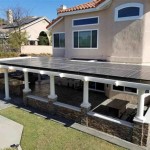How to Install Patio Pavers Against a House
Installing patio pavers against a house significantly enhances the outdoor living space, providing a durable and aesthetically pleasing transition from the interior to the exterior. Proper installation is crucial to prevent water damage to the foundation, ensure structural integrity, and create a long-lasting, visually appealing patio area. This article details the step-by-step process for installing patio pavers against a house, focusing on best practices and essential considerations.
Before commencing any work, it is imperative to check local building codes and regulations regarding patio construction and necessary permits. Certain municipalities may have specific requirements related to drainage, setbacks from property lines, and impervious surface limitations. Consulting with the local building department is highly recommended.
Planning and Preparation
The initial phase of the project involves meticulous planning and preparation. This includes accurately measuring the area where the patio will be installed, selecting the appropriate pavers, and gathering the necessary tools and materials. A well-defined plan will streamline the installation process and minimize potential errors.
Start by determining the desired size and shape of the patio. Clearly mark the boundaries using stakes and string, ensuring that the patio extends away from the house at a slight slope (approximately 1/4 inch per foot) to facilitate water runoff. This slope is crucial to prevent water from pooling against the foundation and potentially causing structural damage.
Next, select the appropriate paver material. Common choices include concrete pavers, brick pavers, and natural stone pavers. Concrete pavers are generally the most cost-effective and offer a wide range of styles and colors. Brick pavers provide a classic and timeless aesthetic. Natural stone pavers, such as flagstone or bluestone, offer a unique and natural look but can be more expensive. Consider the architectural style of the house and the overall desired aesthetic when making a paver selection.
Calculate the amount of pavers needed based on the area of the patio and the size of the chosen pavers. It is advisable to order approximately 5-10% extra pavers to account for cuts and potential breakage. In addition to pavers, you will need base materials, such as crushed stone and sand, as well as edge restraints to contain the pavers and prevent them from shifting over time.
The following tools will be necessary for the installation: a shovel, a rake, a tamper (hand tamper or plate compactor), a level, measuring tape, a string level, a circular saw with a masonry blade or a paver splitter for cutting pavers, safety glasses, work gloves, and a broom.
Furthermore, locate any underground utilities before digging. Contacting the local utility companies to mark the locations of buried lines is paramount to prevent accidental damage during excavation. This step is critical for safety and can prevent costly repairs.
Excavation and Base Preparation
Once the planning phase is complete, the next step is to excavate the area for the patio. The depth of excavation will depend on the total thickness of the base materials and the pavers themselves. A general guideline is to excavate to a depth of approximately 6-8 inches below the desired finished level of the patio.
Remove all vegetation, topsoil, and any other debris from the excavated area. Ensure that the soil is relatively firm and compacted before proceeding. Use a tamper to compact the soil if necessary.
Next, install a base layer of crushed stone. The crushed stone should be approximately 4-6 inches thick and should consist of well-graded aggregate. This layer provides drainage and structural support for the pavers. Spread the crushed stone evenly throughout the excavated area and use a rake to level it. Then, compact the crushed stone thoroughly using a tamper or plate compactor. Compaction is essential to create a stable and durable base.
After compacting the crushed stone, install edge restraints along the perimeter of the patio. Edge restraints can be made of plastic, metal, or concrete. They serve to contain the pavers and prevent them from shifting over time. Secure the edge restraints using stakes or concrete, following the manufacturer's instructions.
Following the installation of edge restraints, a layer of bedding sand is applied. The bedding sand provides a level surface for the pavers and helps to facilitate drainage. The sand should be approximately 1 inch thick and should consist of coarse sand, often referred to as sharp sand or concrete sand. Avoid using fine sand, as it can compact and impede drainage.
Spread the bedding sand evenly over the compacted crushed stone using a rake. Use two pipes or boards as screeds to create a perfectly level surface. Pull a straight board across the screeds to remove excess sand and create a smooth, even layer. It is crucial not to compact the bedding sand, as this will prevent the pavers from settling properly.
Paver Installation
With the base properly prepared, the next step is to install the pavers. Begin laying the pavers along the house, working outwards towards the edge restraints. Place the pavers carefully onto the bedding sand, ensuring that they are tightly butted together.
Use a rubber mallet to gently tap the pavers into place, ensuring that they are level and aligned. Check the level of the pavers frequently using a level and make adjustments as necessary. If a paver is too high, remove it, add a small amount of sand, and replace the paver. If a paver is too low, add sand beneath it.
When laying pavers against the house, it is important to maintain a slight gap (approximately 1/4 inch) between the pavers and the foundation. This gap allows for expansion and contraction of the pavers due to temperature changes and prevents them from putting undue stress on the foundation. This gap is often filled with a flexible sealant or expansion joint material to prevent water from entering between the pavers and the house.
As you reach the edge restraints, you will likely need to cut some of the pavers to fit. Use a circular saw with a masonry blade or a paver splitter to cut the pavers to the desired size and shape. Always wear safety glasses and work gloves when cutting pavers to protect yourself from flying debris.
Continue laying pavers until the entire patio area is covered. Periodically check the overall level and alignment of the pavers using a level and measuring tape. Make any necessary adjustments to ensure that the patio is level and visually appealing.
Finishing Touches and Maintenance
Once all the pavers are laid, the final step is to fill the joints between the pavers with joint sand. Joint sand helps to lock the pavers together and prevent them from shifting over time. It also helps to prevent weeds from growing between the pavers.
Spread joint sand evenly over the entire patio surface using a broom. Sweep the sand into the joints between the pavers, ensuring that they are completely filled. Use a plate compactor with a rubber pad to compact the sand into the joints. This will help to settle the sand and lock the pavers together. If using a plate compactor, ensure the rubber pad is used to prevent damage to the pavers surface.
After compacting the joint sand, sweep away any excess sand from the patio surface. Then, water the patio thoroughly using a garden hose. The water will help to settle the sand and further lock the pavers together. Allow the patio to dry completely before using it.
Key Considerations for Installation Against a House
Installing pavers directly against a house requires special attention to prevent water damage and ensure proper drainage. Several key considerations must be addressed to ensure the patio's longevity and the house's structural integrity.
Proper Slope and Drainage
Maintaining a proper slope away from the house is paramount. The recommended slope is approximately 1/4 inch per foot. This slope ensures that rainwater and snowmelt flow away from the foundation, preventing water from pooling against the house and potentially seeping into the basement or crawl space. The slope should be consistent and gradual across the entire patio surface. In areas with heavy rainfall, consider increasing the slope slightly to further enhance drainage.
Waterproof Barrier and Flashing
Installing a waterproof barrier between the pavers and the house's foundation is crucial for preventing water infiltration. This barrier can consist of a waterproof membrane or flashing that extends up the foundation wall and over the edge of the pavers. The flashing should be properly sealed to the foundation to prevent water from seeping behind it. This barrier acts as a secondary line of defense against water damage, particularly in areas with high water tables or frequent rainfall.
Expansion Joint and Sealant
As mentioned earlier, maintaining a small gap (approximately 1/4 inch) between the pavers and the foundation is essential to allow for expansion and contraction of the pavers due to temperature changes. This gap should be filled with a flexible sealant or expansion joint material. The sealant should be specifically designed for use in exterior applications and should be resistant to water, UV radiation, and temperature fluctuations. Regular inspection and maintenance of the sealant are necessary to ensure its effectiveness over time.
Regular maintenance is essential to keep the patio looking its best and to prevent problems from developing. Sweep the patio regularly to remove leaves, dirt, and debris. Power wash the patio periodically to remove stains and mildew. Reapply joint sand as needed to keep the pavers locked together. Inspect the patio regularly for cracks, chips, or other damage and make repairs promptly. By following these steps, you can ensure that your patio will provide you with years of enjoyment.

Is It Possible To Install Pavers Against The House Foundation

Avoiding Disaster Through Proper Design Of A Raised Paver Patio

How To Install Concrete Pavers Ask This Old House

How To Install Pavers 15 Steps With Pictures Wikihow

How To Build Walkways Around The House With Pavers Howtospecialist Step By Diy Plans

How To Build A Patio In Weekend Finegardening

How To Lay A Paver Walkway With Grass In Between

How To Build A Paver Patio Young House Love

How To Build A Paver Patio Young House Love

What Is The Best Base For Brick Pavers
Related Posts








